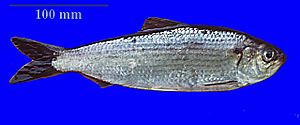Alewife (fish) facts for kids
Quick facts for kids Alewife |
|
|---|---|
 |
|
| Conservation status | |
| Scientific classification | |
| Genus: |
Alosa
|
| Species: |
pseudoharengus
|
| Synonyms | |
|
|
The alewife (Alosa pseudoharengus) is a type of herring fish. It lives in both saltwater and freshwater. These fish are found in North America.
Alewives are known for swimming from the ocean into rivers to lay their eggs. This is called being an anadromous species. Some groups of alewives live only in freshwater lakes. They became very well known for invading the Great Lakes in North America. They used the Welland Canal to get around Niagara Falls.
Contents
What is an Alewife?
Alewives can grow up to about 40 centimeters (16 inches) long. But most of them are around 25 centimeters (10 inches). Their bodies are quite deep and wide at the front. People say the name "alewife" comes from how they look. They might have reminded someone of a plump woman who ran a tavern, called an "ale-wife."
Where Did the Name Come From?
In some parts of Nova Scotia, alewives are called "kiacks." In Atlantic Canada, they are often known as "gaspereau." This name comes from an old French word, gasparot.
A historian named William Francis Ganong wrote about the name. He said the word "gaspereau" was first used in 1672. He couldn't find out where it came from, but it didn't seem to be an Indigenous word.
Two rivers in Canada were named after this fish. One is the Gaspereau River in Nova Scotia. The other is the Gaspereau River in New Brunswick.
In eastern Massachusetts, there's a place called Alewife Brook. It flows through several towns. The brook also gave its name to a parkway and a reservation. Even a subway station in Boston is called Alewife station. So, the name of this fish is seen on the front of many trains!
Efforts are being made to help more alewives return to the Mystic River. They are building special "fish ladders" to help the fish swim upstream.
Alewives in the Great Lakes
Alewives are famous for how they spread into the Great Lakes. They used the Welland Canal to bypass Niagara Falls. This allowed them to enter lakes like Lake Huron and Lake Michigan.
Their numbers grew very quickly from the 1950s to the 1980s. This happened because there were not enough natural predators in the lakes. For example, lake trout numbers had dropped. Also, the sea lamprey had invaded the lakes.
Sometimes, huge numbers of alewives would die. Their bodies would wash up on the shores of the Great Lakes. To control the alewife population, different types of Pacific salmon were introduced. These included Coho salmon and Chinook salmon. This helped a little. It also created a popular sport fishery for salmon.
Even with these efforts, alewives have caused problems for many native fish species in the Great Lakes. They also eat many tiny water creatures called zooplankton.
Why Are Alewives Important?
Alewives are often caught during their spring journey upstream. People use large nets to scoop them out of shallow areas. They are a popular bait for catching lobsters in Maine. People also eat them, often after they have been smoked.
Conservation Efforts
The number of alewives has been decreasing in many places. Several things have caused this decline:
- Loss of habitat: Dams and other barriers stop them from reaching their spawning areas.
- Habitat damage: Their homes in rivers and streams are being harmed.
- Fishing: Catching too many fish can reduce their numbers.
- More predators: The number of striped bass, which eat alewives, has increased.
Because of these declines, some states have stopped people from catching or owning alewives. These states include Massachusetts, Rhode Island, Connecticut, Virginia, and North Carolina.
The US National Marine Fisheries Service considers the alewife a "Species of Concern." This means they are worried about the fish's status. However, there isn't enough information yet to list them as an endangered species.
See also
 In Spanish: Pinchagua para niños
In Spanish: Pinchagua para niños


